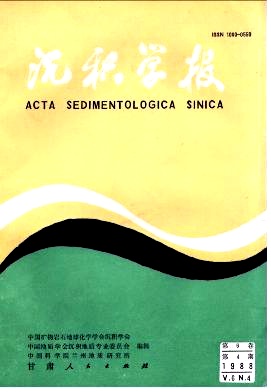DEPOSITIONAL FEATURES AND PALAEOHYDRAULIC CONDITIONS OF THE FLUVIAL SEDIMENTS OF TOUTUNHE FORMATION,MIDDLE JURASSIC, IN SOUTHERN CHANGJI PREFECTURE,XINJIANG
- Received Date: 1986-09-09
- Publish Date: 1988-12-10
Abstract: Sedimentary Environments of the Toutunhe Formation in Southern Changji Prefecture,Xinjiang,have been systematically investigated by field observetion and using the techniques of thin-section examination,X-ray diffraction,scanning electronic-microscopy,cathodoluminescone micros-copy,stable isotope analysis,grain-size analysis,methematical statistics, etc.From southern to northern part of the studied area,Toutunhe Formation is represented by a succession of fluvial,deltaic and lacustrine deposits.At the Sulphur Valley section,the fluvial facies-association comprises four cycles each of which consists of a lower coarse member and an upper fine member. 11 lithofacies havebeen distinguished from these cyclic sediments: (1) Massive conglomerate facies (Gm),for which thicker beds situating at lower part of the cycle and streching laterally in a distance more than 10m are referred to lag deposits and thinner conglomerates laying in the scour hole on top of large-sea le tabular cross-bed sandstones are assumed to be chute fill.(2) Tabular cross-bed conglomerate (Gp) is produced by lateral migration of point-bar. (3) Large-scale cross-bed sandstone facies (St)- those with multiple cetts might be produced by the migration of sinuous-ridge dunes at the upper part of point bar and those with solitary set by filling-up of scour hole. (4) Large-scale tabular cross-bed sandstone facies (Sp) are produced by sand bar or scrollbar. (5) -cross-bedding sandstone facies (ε) with four-grade boundaries,It is evidence of lateral accretion of point bar. (6) Smallscalc cross-bed fine-sandstone facies (S1). (7) Ripple-bedded siltstonc facies (Sr) occur at the top of point-bar,on natural lavee and in oxbow lakes. (8) C-hannel plug silty mudstone facies (Cp). (9) Chute plug facies (Ccp) and (11) Pa-leosol facies (Psc) of mottled mudstone is intercalated with low-quality coal seams.The vertical facies-relationship and facies-model have been worked out by us-eing Selley's (1970) technique of transform matrix.The model is similar to that of the Old Red Sands-tone (Allen,1963) but even more complex.Inside the sand-bodies of Toutunhe Formation no simple upwards-fining sequence is found, instead, up- wards-coarsening often occurring on the basal scour surface of the conglomerate lenses. The presence of tabular cross bedds at upper part of the coarse m-embers and the occurrence of e-cross bedds suggest typical meandering river depo-its. Besides, the rapid facies-change, frequent scour structures and abundant conglomerate and mudstone lenses might suggest that the corresponing rivers were characterized by shallow water, high flow-velocity, unstable currents and ample detritus supplies. The Paleocurrent directions from measurements of cross-bedds, oblate gravels and loggs show a preferred azimuth between 260° and 61° which coincides well with the regional transport-direction North to Tien- Shan Mountain. Parameters of channelgeomorphology and hydraulics for cycle 1-3 have been worked out by employing the equations of Schumm (1960, 1963, 1968), Cotter (197 1), Eicher (1969) and Hack (1957). They suggest that during the period of cycle 1 to that of cycle 3, the corresponding rivers were getting deeper and broader and their channel sinuosity, length and curvature radius getting greater, but the channel slope getting smaller. These implicate a tendancy of increasing river scale, channel stability, annual mean discharge and suapended-load and decreasing flow velocity and bed-load. It is obvious that the rivers of cycle 3 were approching more to the lower reach than that of cycle 1 and 2, owing to the influence of climates and tectonic movements. But the innercycle-3 rivers evoluted in an opposite way, i.e., from former to later stage, the rivers were decreased in scale sinnosity and suspended-load but increased in slope and bed-load, which might be explained by an uplifting source area and a drier climate. It is presumed that the ancient Tou-tunhe river is similar to the modern Dane River in Great Britain. Both are of m-ixed-load channel types.
| Citation: | Yang Chao, Zhao Xiafe. DEPOSITIONAL FEATURES AND PALAEOHYDRAULIC CONDITIONS OF THE FLUVIAL SEDIMENTS OF TOUTUNHE FORMATION,MIDDLE JURASSIC, IN SOUTHERN CHANGJI PREFECTURE,XINJIANG[J]. Acta Sedimentologica Sinica, 1988, 6(4): 33-43. |






 DownLoad:
DownLoad: